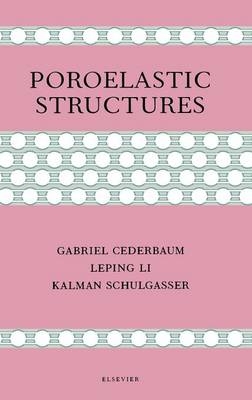
Poroelastic Structures
Elsevier Science Ltd (Verlag)
978-0-08-043668-5 (ISBN)
- Titel ist leider vergriffen;
keine Neuauflage - Artikel merken
Poroelasticity is a continuum theory for the analysis of a porous media consisting of an elastic matrix containing interconnected fluid-saturated pores. In physical terms the theory postulates that when a porous material is subjected to stress, the resulting matrix deformation leads to volumetric changes in the pores. This book is devoted to the analysis of fluid-saturated poroelastic beams, columns and plates made of materials for which diffusion in the longitudinal direction(s) is viable, while in the perpendicular direction(s) the flow can be considered negligible because of the micro-geometry of the solid skeletal material. Many microstructures and fabrication schemes could be imagined, which would produce bulk materials with the postulated behavior. The book provides a methodology and a theoretical basis for investigating the mechanical behaviors of the structural elements made of such materials. It is recognized that the response of the poroelastic structural element to loading is sensitive to the properties of the fluid and to the diffusion boundaries, which can be easily altered in practice. Therefore, such structural elements and thus their features are potentially controllable. In other words, it could be possible to convert such elements into intelligent or smart structures. If this is so, it would be interesting that such structural elements could work as both sensors and actuators, e.g. the fluid can "feel" the change of the temperature by changing its viscosity and this results in a change of the behavior of the structure. The present book is the first of its kind; there does not exist in the professional literature any book which deals with this subject.Chapter 1 is a general introduction and overview. The governing equations for beams are presented in Chapter 2. Chapter 3 then presents analytical solutions for the quasi-static bending problem. Series solutions are found for normal loading with various mechanical and diffusion boundary conditions. The finite element method is developed and employed for the quasi-static beams and columns with small deflections in Chapter 4. In Chapter 5 solutions are found for free and forced vibrations of poroelastic beams. Chapter 6 deals with large deflections of beams. The stability of poroelastic columns is investigated in Chapter 7. Three problems are considered: buckling, post-buckling, and dynamic stability. Formulations are found in Chapter 8 for fluid-saturated poroelastic plates consisting of a material, for which the diffusion is possible in the in-plane directions only, both for bending and for in-plane loading. This book attempts to constitute a reasonably self-contained presentation of a wide spectrum of problems related to the analysis of the type of poroelastic structure considered.
Introduction. Modeling of Poroelastic Beams. Basic equations. Characteristic times. Note on a beam impermeable at both ends. Equations in non-dimensional form. Analytical Solutions for Quasi-Static Beams. Simply-supported beams with permeable ends. Beams subjected to loads suddenly applied and constant thereafter. Finite Element Formulation and Solutions for Quasi-Static Beams. Introduction. Variational principles. Finite element formulation. Examples and discussion. Vibrations of Poroelastic Beams. Initial value problems. Forced harmonic vibrations. Closure. Large Deflection Analysis of Poroelastic Beams. Governing equations. Equations in non-dimensional forms when &egr;0 =0. Numerical formulation. Numerical procedure for the finite difference method. Examples and discussion. Stability of Poroelastic Columns. Buckling of columns. Limits of critical load. Time-dependence of critical load and deflections. Post-buckling: formulation. Post-buckling: results and discussion. Imperfection sensitivity. Dynamic stability of poroelastic columns. Stability boundaries and critical load amplitude. Analysis of Poroelastic Plates. Basic equations for thin plates. Analytical solutions for quasi-static bending. Transverse vibrations of simply supported plates. Closure. Appendices. Subject index.
| Erscheint lt. Verlag | 12.7.2000 |
|---|---|
| Verlagsort | Oxford |
| Sprache | englisch |
| Gewicht | 470 g |
| Themenwelt | Technik ► Maschinenbau |
| ISBN-10 | 0-08-043668-4 / 0080436684 |
| ISBN-13 | 978-0-08-043668-5 / 9780080436685 |
| Zustand | Neuware |
| Haben Sie eine Frage zum Produkt? |
aus dem Bereich


